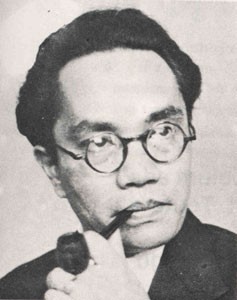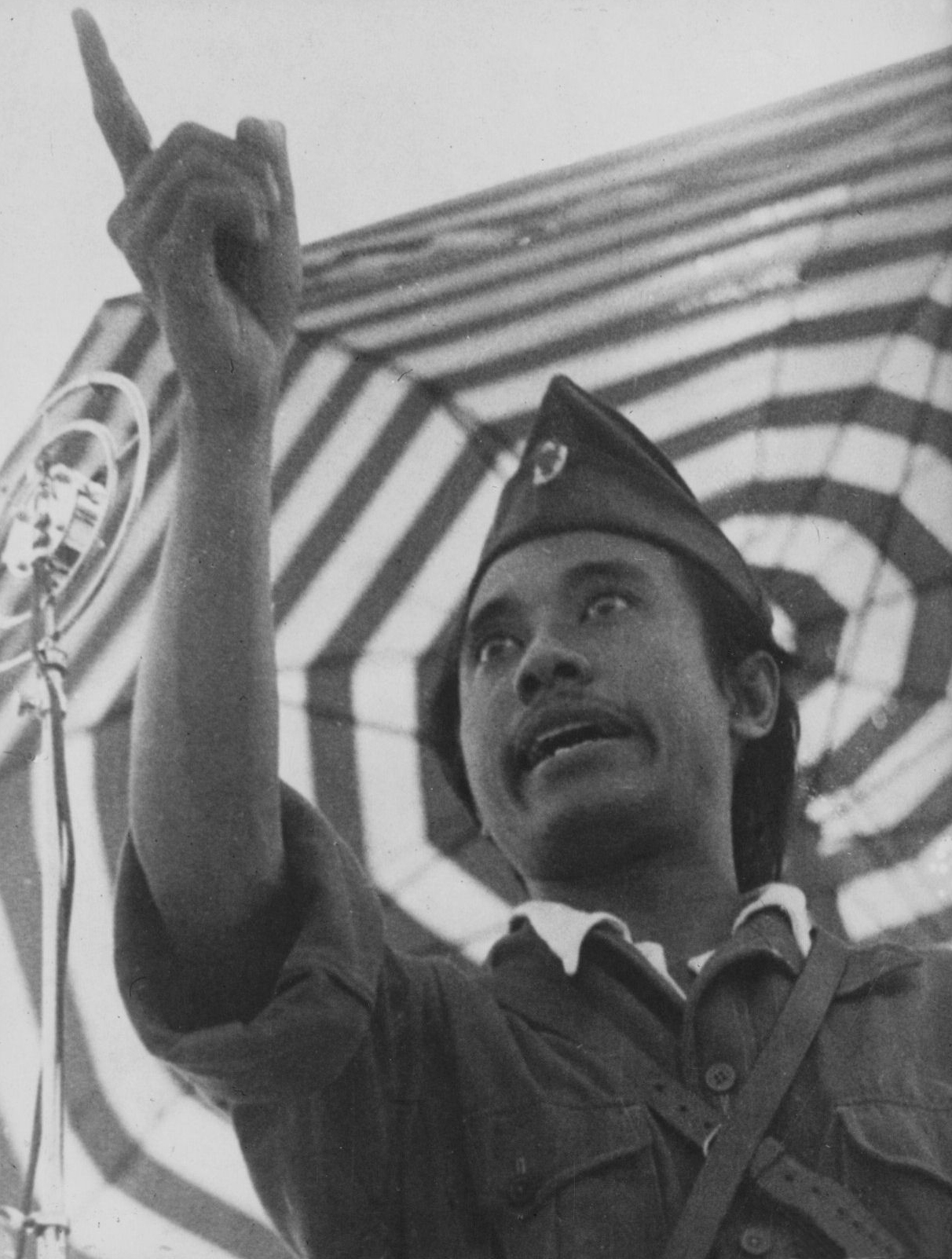|
Pesindo
People's Youth (Indonesian: ''Pemuda Rakyat'') was the youth wing of the Communist Party of Indonesia (PKI). The organisation was formed as the Socialist Youth of Indonesia (''Pemuda Sosialis Indonesia'' or ''Pesindo''). Initially the organisation was set up on the initiative of then Minister of Defence Amir Sjarifuddin, as the youth wing of the Socialist Party of Indonesia. A congress was held on 10 and 11 November 1945, where seven locally based youth outfits merged. Rapidly it gained a membership of around 25,000. The organisation took part in the armed struggle for independence during the Indonesian National Revolution. Pesindo units were engaged in intense street fighting during the Battle of Surabaya. Pesindo took part, along with PKI and FDR, in the Madiun Uprising in 1948. In 1950 the organisation established its ties to the Indonesian Communist Party (PKI) and changed its name to "''Pemuda Rakyat''". At the congress of November 1950 Francisca C. Fanggidaej became the c ... [...More Info...] [...Related Items...] OR: [Wikipedia] [Google] [Baidu] |
Madiun Uprising
The Madiun Affair ( id, Peristiwa Madiun), known locally as the Communist Party of Indonesia rebellion of 1948 ( id, Pemberontakan Partai Komunis Indonesia 1948), was an armed conflict between the government of the self-proclaimed Republic of Indonesia and the left-wing opposition group ''Front Demokrasi Rakyat'' (FDR, People's Democratic Front) during the Indonesian National Revolution. The conflict began on September 18, 1948, in Madiun, East Java, and ended three months later when most FDR leaders and members were detained and executed by TNI forces. Background Downfall of Sjarifuddin Cabinet and the formation of Hatta Cabinet Opinions regarding the trigger of the conflict vary. According to Kreutzer, the downfall of Amir Sjarifuddin government in January 1948 was the origin of the Madiun Affair. Before then, during the second half of the 1947, Partai Sosialis was split into two factions: one faction was led by Sjarifuddin and a smaller faction led by Sutan Sjahrir. The ... [...More Info...] [...Related Items...] OR: [Wikipedia] [Google] [Baidu] |
People's Democratic Front (Indonesia)
People's Democratic Front ( id, Front Demokrasi Rakjat, FDR) was a short-lived united front of leftists in Indonesia, founded in February 1948. FDR included the Communist Party of Indonesia, the Socialist Party, Labour Party of Indonesia, SOBSI and Pesindo. The leader of FDR was Amir Sjarifuddin.Masatoshi, Kisaichi. Popular Movements and Democratization in the Islamic World'. London: Routledge, 2006. p. 110 References 1948 establishments in Indonesia Communist Party of Indonesia Defunct left-wing political party alliances Defunct political parties in Indonesia Defunct political party alliances in Asia Defunct socialist parties in Asia Political parties established in 1948 Political parties with year of disestablishment missing Political party alliances in Indonesia Socialist parties in Indonesia Indonesia Indonesia, officially the Republic of Indonesia, is a country in Southeast Asia and Oceania between the Indian and Pacific oceans. It consists of over 17,000 ... [...More Info...] [...Related Items...] OR: [Wikipedia] [Google] [Baidu] |
Communist Party Of Indonesia
The Communist Party of Indonesia (Indonesian: ''Partai Komunis Indonesia'', PKI) was a communist party in Indonesia during the mid-20th century. It was the largest non-ruling communist party in the world before its violent disbandment in 1965. The party had two million members in the 1955 elections, with 16 percent of the national vote and almost 30 percent of the vote in East Java. During most of the period immediately following independence until the eradication of the PKI in 1965, it was a legal party operating openly in the country. History Forerunners The Indies Social Democratic Association (Dutch: ''Indische Sociaal-Democratische Vereeniging'', ISDV) was founded in 1914 by Dutch socialist Henk Sneevliet and another Indies socialist. The 85-member ISDV was a merger of the two Dutch socialist parties (the SDAP and the Socialist Party of the Netherlands), which would become the Communist Party of the Netherlands with Dutch East Indies leadership. The Dutch members of the ... [...More Info...] [...Related Items...] OR: [Wikipedia] [Google] [Baidu] |
Indonesian Language
Indonesian ( ) is the official language, official and national language of Indonesia. It is a standard language, standardized variety (linguistics), variety of Malay language, Malay, an Austronesian languages, Austronesian language that has been used as a lingua franca in the multilingual Indonesian archipelago for centuries. Indonesia is the fourth most list of countries by population, populous nation in the world, with over 270 million inhabitants—of which the majority speak Indonesian, which makes it one of the most List of languages by total number of speakers, widely spoken languages in the world.James Neil Sneddon. ''The Indonesian Language: Its History and Role in Modern Society''. UNSW Press, 2004. Most Indonesians, aside from speaking the national language, are fluent in at least one of the more than 700 indigenous languages of Indonesia, local languages; examples include Javanese language, Javanese and Sundanese language, Sundanese, which are commonly used at home a ... [...More Info...] [...Related Items...] OR: [Wikipedia] [Google] [Baidu] |
Amir Sjarifuddin
Amir Sjarifuddin Harahap ( EVO: Amir Sjarifoeddin Harahap; 27 April 1907 – 19 December 1948) was an Indonesian politician and journalist who served as the second prime minister of Indonesia from 1947 until 1948. A major leader of the left-wing during the Indonesian National Revolution, he previously served as Minister of Information from 1945 until 1946 and Minister of Defense from 1945 until 1948. Amir was born into the Sumatran aristocracy, and was educated at Leiden University. At Leiden, he became a member of the board of the Gymnasium student association in Haarlem, and was involved in the Batak student organization '' Jong Batak''. He returned to Indonesia due to family troubles, but continued his education at the '' Rechts Hogeschool'' in Batavia. After graduating, he became active in literary and journalist circles, joining the editorial board of the newspaper ''Panorama''. He also became involved with left-wing politics, and led a group of younger Marxist ... [...More Info...] [...Related Items...] OR: [Wikipedia] [Google] [Baidu] |
Socialist Party Of Indonesia
The Socialist Party of Indonesia ( id, Partai Sosialis Indonesia) was a political party in Indonesia from 1948 until 1960, when it was banned by President Sukarno. Origins In December 1945 Amir Sjarifoeddin's Socialist Party of Indonesia (Parsi) and Sutan Sjahrir's Socialist People's Party (Parsas), both of which had only recently been established, merged to form the Socialist Party. Sjahrir became leader of the combined party. It was popular among young intellectuals and students as well as members of the underground movements led by the two men during the Japanese occupation of Indonesia.Kahin (1952) p158 At the end of 1945 the Socialist Party gained five of the 25 seats on the working committee of the Central Indonesian National Committee, the ''de facto'' legislature.Kahin (1952) p171 Both Sutan and Amir served terms as prime minister, while other Socialist Party members held senior cabinet posts.Simanjuntak (2003) From 1947, divisions appeared between Sutan and Amir as A ... [...More Info...] [...Related Items...] OR: [Wikipedia] [Google] [Baidu] |
Indonesian National Revolution
The Indonesian National Revolution, or the Indonesian War of Independence, was an armed conflict and diplomatic struggle between the Republic of Indonesia and the Dutch Empire and an internal social revolution during Aftermath of WWII, postwar and Dutch East Indies#World War II and independence, postcolonial Indonesia. It took place between Indonesian Declaration of Independence, Indonesia's declaration of independence in 1945 and the Netherlands' Dutch–Indonesian Round Table Conference, transfer of sovereignty over the Dutch East Indies to the Republic of the United States of Indonesia at the end of 1949. The four-year struggle involved sporadic but bloody armed conflict, internal Indonesian political and communal upheavals, and two major international diplomatic interventions. Dutch military forces (and, for a while, the forces of the World War II Allies, World War II allies) were able to control the major towns, cities and industrial assets in Republican heartlands on Ja ... [...More Info...] [...Related Items...] OR: [Wikipedia] [Google] [Baidu] |
Battle Of Surabaya
The Battle of Surabaya was fought between regular infantry and militia of the Indonesian nationalist movement and British and British Indian troops as a part of the Indonesian National Revolution against the re-imposition of Dutch colonial rule. The peak of the battle was in November 1945. The battle was the largest single battle of the revolution and became a national symbol of Indonesian resistance. Considered a heroic effort by Indonesians, the battle helped galvanise Indonesian and international support for Indonesian independence. 10 November is celebrated annually as Heroes' Day (). By the time the Allied forces arrived at the end of October 1945, the ''Pemuda'' ("youth") foothold in Surabaya City was described as "a strong unified fortress". Fighting broke out on 30 October after the British commander, Brigadier A. W. S. Mallaby was killed in a skirmish. The British retaliated with a co-ordinated sweep that began on 10 November, under the cover of air attacks. Althou ... [...More Info...] [...Related Items...] OR: [Wikipedia] [Google] [Baidu] |
Francisca C
The francisca (or francesca) is a throwing axe used as a weapon during the Early Middle Ages by the Franks, among whom it was a characteristic national weapon at the time of the Merovingians from about 500 to 750 and is known to have been used during the reign of Charlemagne (768–814). Although generally associated with the Franks, it was also used by other Germanic peoples of the period, including the Anglo-Saxons; several examples have been found in England.Underwood, Richard (1999). ''Anglo-Saxon Weapons and Warfare''. p.35-37. Tempus Publishing. . Etymology The term ''francisca'' first appeared in the book '' Etymologiarum sive originum, libri XVIII'' by Isidore of Seville (c. 560–636) as a name used in Hispania to refer to these weapons "because of their use by the Franks". The historian Gregory of Tours (c. 538–594) in his ''History of the Franks'' uses two Latin terms for the Frankish axe: ''securis'' and ''bipennis''. The régime of Vichy France used the image o ... [...More Info...] [...Related Items...] OR: [Wikipedia] [Google] [Baidu] |
Indonesian Killings Of 1965–66
Indonesian is anything of, from, or related to Indonesia, an archipelagic country in Southeast Asia. It may refer to: * Indonesians, citizens of Indonesia ** Native Indonesians, diverse groups of local inhabitants of the archipelago ** Indonesian women, overview of women's history and contemporary situations * Indonesian language (Indonesian: ''Bahasa Indonesia''), the official language of Indonesia ** Indonesian languages, overview of some of the 700 languages spoken in Indonesia ** Indonesian names, customs reflecting the multicultural and polyglot nature of Indonesia * Indonesian culture, a complex of indigenous customs and foreign influences ** Indonesian art, various artistic expressions and artworks in the archipelago ** Indonesian cinema, a struggling and developing industry ** Indonesian literature, literature from Indonesia and Southeast Asia with shared language roots ** Indonesian music, hundreds of forms of traditional and contemporary music ** Indonesian philosophy, ... [...More Info...] [...Related Items...] OR: [Wikipedia] [Google] [Baidu] |
Youth Wings Of Communist Parties
Youth is the time of life when one is young. The word, youth, can also mean the time between childhood and adulthood ( maturity), but it can also refer to one's peak, in terms of health or the period of life known as being a young adult. Youth is also defined as "the appearance, freshness, vigor, spirit, etc., characteristic of one, who is young". Its definitions of a specific age range varies, as youth is not defined chronologically as a stage that can be tied to specific age ranges; nor can its end point be linked to specific activities, such as taking unpaid work, or having sexual relations. Youth is an experience that may shape an individual's level of dependency, which can be marked in various ways according to different cultural perspectives. Personal experience is marked by an individual's cultural norms or traditions, while a youth's level of dependency means the extent to which they still rely on their family emotionally and economically. Terminology and definitio ... [...More Info...] [...Related Items...] OR: [Wikipedia] [Google] [Baidu] |








